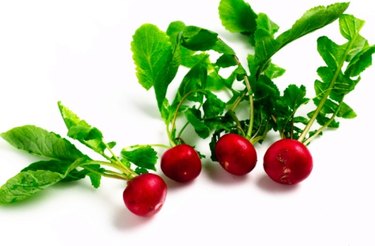
Quick to mature and resistant to pests, radishes are some of the easiest garden vegetables to grow. The tasty roots are somewhat picky about the conditions in which they develop, however, and understanding the factors affecting the plants at each stage of their growth can make producing a healthy crop of radishes even easier.
Germination
Video of the Day
Radishes are a quick-growing cool-weather. Plant in the early spring, after the soil reaches 40 degrees Fahrenheit, or in late summer. Germination is most reliable when air temperatures are 55 to 75 F. Plant seeds 1/2 inch to 1 inch deep, and keep the soil moist until germination occurs. Seedlings emerge in five to 10 days.
Video of the Day
Seedling
Once the seedlings emerge, thin the plants so there is at about one inch between them. Thinning seedlings when they have only two or three leaves minimizes the disturbance of the roots of nearby plants, which can hurt development. During the seedling stage, radishes are especially sensitive to moisture fluctuation, heat and competition from weeds; control these factors to ensure good root development. To increase the chances of a good crop, water consistently, use a shade cover to control temperature and weed carefully to avoid disturbing the radish roots.
Maturity
Harvest radishes when their roots reach full size. For most varieties, that is when the roots are 1 to 1 1/2 inches in diameter, usually 25-45 days after planting. Root flavor is best when the plant grows quickly and temperatures remain cool. Inconsistent watering and temperatures above 80 F makes radishes "hot."
After Maturity
If allowed to continue growing after their roots reach an adequate size for harvesting, radish plants "bolt" and produce flowers. Heat early in the season can also encourage early bolting. At this stage, the roots quickly become inedible, turning pithy and often cracking. The flavor of the roots also deteriorates as the temperature increases. Plant a second crop of radishes in late summer for a late-season harvest.